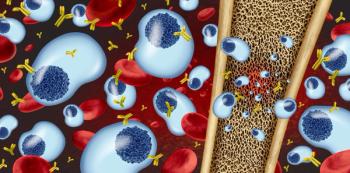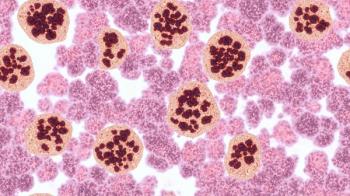
ASCO 2025 Delivers Insights into Future of Myelofibrosis Care
Key Takeaways
- Myelofibrosis treatment focuses on disease control and quality of life, with JAK inhibitors as the standard of care.
- Ruxolitinib reduces spleen volume and symptoms but may worsen anemia; newer JAK inhibitors offer alternatives.
Explore the latest advancements in myelofibrosis treatment, focusing on JAK inhibitors and pegylated interferons for improved patient outcomes.
Myelofibrosis (MF) is a myeloproliferative neoplasm (MPN) characterized by significant bone marrow scarring, extramedullary hematopoiesis, recurrent splenomegaly, and anemia due to a progressive reduction in generation of red blood cells. MF is incurable, so treatment is focused on disease control and improving quality of life. Therapeutic options can include stem cell transplantation, supportive care, pegylated interferons, novel agents, or Janus kinase (JAK) inhibitors—which have become the standard of care.
At the 2025 ASCO Annual Meeting, experts discussed emerging treatment options for myeloproliferative neoplasms, highlighting the efficacy of novel JAK inhibitors. Ruxolitinib (Jakafi; Incyte Corp) remains a key therapy, demonstrating strong benefits in reducing spleen volume and alleviating disease-related symptoms. Additionally, newer agents such as pacritinib (Vonjo; CTI BioPharma) and momelotinib (Ojjaara; GSK) offer effective alternatives with less myelosuppression. Pegylated interferons were also emphasized for their durable molecular responses and manageable toxicity profiles, making them particularly valuable for younger patients and those harboring driver mutations.
JAK Inhibitors
"Jak inhibitors are the mainstay of treatment for myelofibrosis,” said Andrew Tucker Kuykendall, MD, from H. Lee Moffitt Cancer Center and Research Institute. “We'd certainly like to change that and bring new agents to the table, but it remains the Jak inhibitors are the common, most common therapy for our patients.”1
Ruxolitinib
Ruxolitinib is a JAK inhibitor approved by the FDA in 2011 that is indicated for treating patients with high-risk MF with reduced abnormal expression of PF4, which can lead to decreased fibrosis. It is associated with substantial clinical benefits, including reducing spleen volume by over 35%, rapid improvements in disease-related symptoms, potential survival benefit, especially in early disease stages, and even reducing fibrosis. However, ruxolitinib is strongly associated with the development of dose-dependent anemia or the worsening of existing anemia.1
The standard dosing is typically 20 mg twice daily, but doses may be adjusted based on patient's blood counts and tolerability. Although it remains the cornerstone of treatment for MF, newer JAK inhibitors like pacritinib and momalotinib are emerging as alternatives, especially for patients who experience significant anemia with ruxolitinib.1
Momolitinib
Momelotinib is an adenosine triphosphate-competitive JAK inhibitor that targets JAK1, JAK2, JAK3, and TYK2. It received FDA approval in 2023 for the treatment of patients with anemia and high/intermediate-risk MF, which includes the primary and secondary variants polycythemia vera or essential thrombocythemia. Momelotinib demonstrates superior benefit to other JAK inhibitors across multiple clinical trials, showing benefits such as reduced anemia.1
In the phase 3 SIMPLIFY trial (NCT01969838), researchers conducted a head-to-head, noninferiority study of momelotinib and ruxolitinib in a 1:1 randomized trial of treatment-naive patients. The data showed a noninferior spleen response with less effective symptom improvement (42% vs 28%) in patients treated with momelotinib. However, it demonstrated better performance in patients with higher baseline hemoglobin.1,2
"Momelotinib was noninferior in terms of spleen response. However, it was not noninferior in terms of symptom improvement, where we saw ruxolitinib was associated with a symptom response or a 50% reduction in symptom score of 42% compared to just 28% with momelotinib," said Kuykendall.1
The SIMPLIFY-2 (NCT02101268) trial focused on patients previously treated with ruxolitinib and randomly assigned them to receive either momelotinib or the best available therapy, with no washout period between treatments. Although spleen response was minimal in both groups (7% with momelotinib vs 6% with best available therapy), momelotinib demonstrated a significant reduction in total symptom score by 26%. Notably, the therapy was particularly beneficial for patients who developed anemia while on ruxolitinib.1,3
Kuykendall also highlighted the MOMENTUM trial (NCT04173494)—a phase 3 study specifically designed for patients with MF who had prior exposure to ruxolitinib and were also experiencing anemia. Patients were randomly assigned 2:1 to receive either momelotinib or danazol, an androgen commonly used to manage anemia. The trial demonstrated a clear clinical advantage for momelotinib, with a 25% symptom response rate compared to just 9% with danazol, and a spleen volume response rate of 22% vs 3%, respectively. Importantly, momelotinib was also associated with improved rates of transfusion independence, addressing a key unmet need in this patient population. These benefits were sustained over time, with extended follow-up showing durable responses in both symptom control and anemia management.1,4
Pacratinib
Pacritinib is a JAK inhibitor used to treat intermediate or high-risk MF that targets JAK2 and FMS-like tyrosine kinase 3. It was approved by the FDA in 2022 for treatment of both primary and secondary MF in patients with platelet counts less than 50 x 109/L. Pacritinib demonstrated it clinical benefit in the PERSIST-1 (NCT01773187) and PERSIST-2 (NCT02055781) studies evaluated pacritinib in patients with MF, particularly those with cytopenias. PERSIST-1 enrolled frontline patients with higher-risk MF and compared pacritinib 400 mg daily to best available therapy. The study met its primary end point, demonstrating a spleen volume response rate of 19% compared with 5% with standard treatment. However, it did not meet the threshold for symptom response. Despite this, pacritinib showed consistent efficacy in patients with thrombocytopenia.1,5,6
PERSIST-2 built on these findings by focusing specifically on patients with platelet counts below 100,000/μL and randomized them to different doses of pacritinib or best available therapy. A post hoc analysis revealed that pacritinib is also a potent ACVR1 inhibitor, which may contribute to its potential anemia benefits. Notably, responses to pacritinib were not influenced by baseline cytopenias, making it a promising option for patients with low hemoglobin or platelet levels. Its ability to maintain efficacy in cytopenic patients and potentially improve anemia parameters positions pacritinib as a valuable therapy in a population with limited treatment options.1
"The responses observed with pacritinib do not appear to be affected by baseline cytopenias. The rates of achieving a spleen volume reduction of 35% and greater or symptom improvement of 30% to 50% are comparable regardless of whether a patient’s hemoglobin is above 10 g/dL, between 8 to 10 g/dL, or whether they have low platelet counts."1
Pegylated Interferons
Pegylated interferons were first introduced in 1957 and were used to treat viral infections such as hepatitis. Initially, the nonpegylated versions were multiweek dosing injections that were not well tolerated, leading to pegylated formulations with improved tolerability and extended dosing intervals. Use of pegylated interferons for MPNS began in the late 1980s and may continue to have benefits despite their age and the emergence of novel agents.1
"Interferons are absolutely still a major player in MPNS. They have high clinical efficacy and manageable toxicities, superior molecular responses, and potential disease-modifying activity."1
Pegylated interferons have demonstrated high clinical efficacy in patients with essential thrombocythemia (ET) and polycythemia vera (PV), with response rates around 80%. These agents also show superior molecular responses compared to other frontline therapies, suggesting potential disease-modifying activity. Notably, they may play a role in delaying disease progression, an important consideration for long-term disease management.1
Several key clinical trials support these findings. Phase 2 studies have consistently reported response rates of 70% to 80%. In the PROUD-PV study (NCT01949805), sustained responses were observed at 36 months, with a 71% response rate in patients treated with ropeginterferon compared to 51% in those receiving hydroxyurea. Molecular responses with interferon therapy appeared to improve over time, further underscoring its long-term benefit.1,7
From a patient care perspective, pegylated interferons offer manageable toxicities and are considered safe for use during pregnancy. They may also improve life expectancy and are especially beneficial for younger patients with ET. However, they are contraindicated in individuals with severe mood disorders, autoimmune conditions, or chronic hepatitis, and careful patient selection is essential for optimal outcomes.1
As research in MPNs continues to evolve, the treatment landscape for MF and related disorders is expanding beyond traditional approaches. Although JAK inhibitors like ruxolitinib remain foundational in clinical practice, novel agents such as momelotinib and pacritinib offer meaningful advantages for patients with anemia or thrombocytopenia. In parallel, the enduring utility of pegylated interferons highlights their relevance, particularly in younger patients. Together, these emerging and established therapies pave the way for a broader movement toward more personalized, tolerable, and disease-modifying strategies.
REFERENCES
1. Klisovic R, Kuykendall A, Hughes T. Myeloproliferative neoplasms and chronic myelogenous leukemia: New directions in therapies and sequencing oral agents. 2025 ASCO Annual Meeting. May 30, 2025, to June 3, 2025. Chicago, IL.
2. Momelotinib versus ruxolitinib in subjects with myelofibrosis (Simplify 1). Updated May 12, 2023. Accessed June 3, 2025. https://clinicaltrials.gov/study/NCT01969838
3. Efficacy of momelotinib versus best available therapy in anemic or thrombocytopenic subjects with primary myelofibrosis (MF), post-polycythemia vera MF, or post-essential thrombocythemia MF (Simplify 2). Updated May 23, 2023. Accessed June 3, 2025. https://clinicaltrials.gov/study/NCT02101268
4. A study of momelotinib versus danazol in symptomatic and anemic myelofibrosis participants (MOMENTUM). Updated November 1, 2023. Accessed June 3, 2025. https://clinicaltrials.gov/study/NCT04173494
5. Pacritinib versus best available therapy to treat myelofibrosis. September 29, 2020. Accessed June 3, 2025. https://clinicaltrials.gov/study/NCT01773187
6. Pacritinib versus best available therapy to treat patients with myelofibrosis and thrombocytopenia (pac326). ClinicalTrials.gov Identifier: NCT02055781. Updated November 18, 2021. Accessed October 15, 2024. https://clinicaltrials.gov/study/NCT02055781
7. Pegylated interferon Aapha-2b versus hydroxyurea in polycythemia vera (PROUD-PV). November 28, 2016. Accessed June 3, 2025. https://clinicaltrials.gov/study/NCT01949805
Newsletter
Stay informed on drug updates, treatment guidelines, and pharmacy practice trends—subscribe to Pharmacy Times for weekly clinical insights.



















































































































































































































